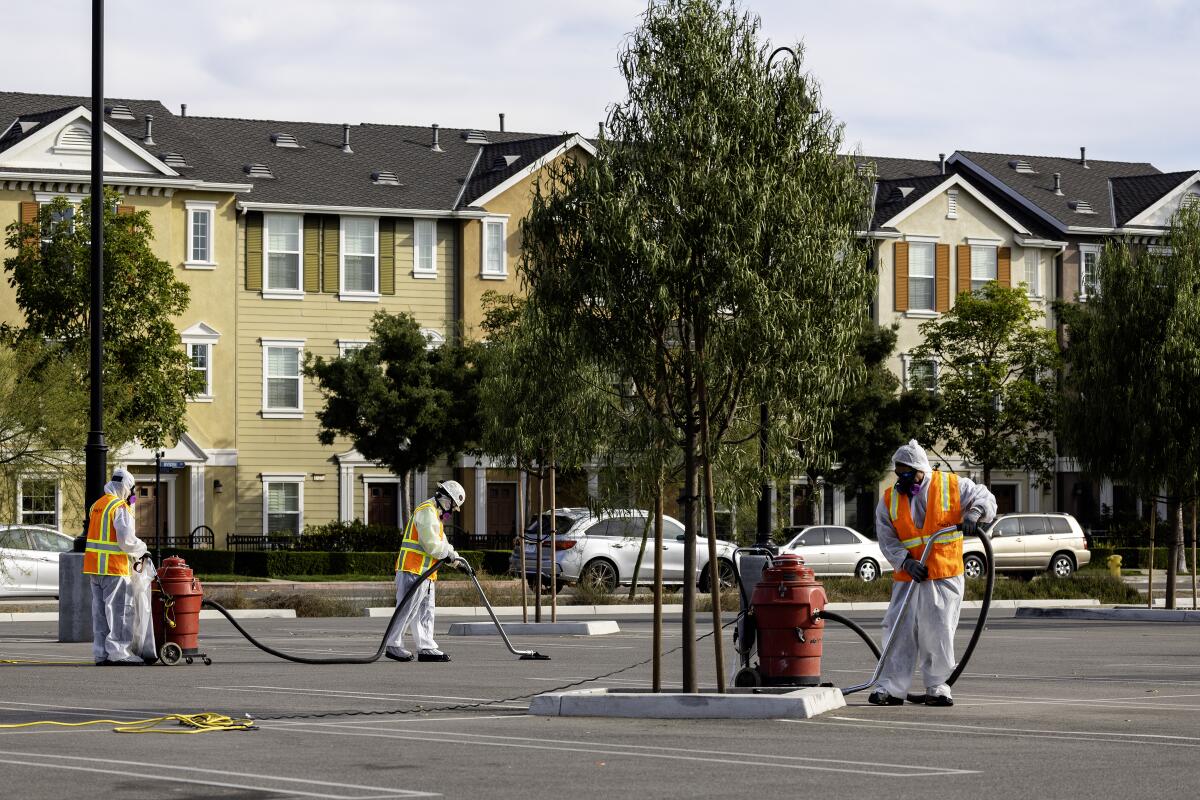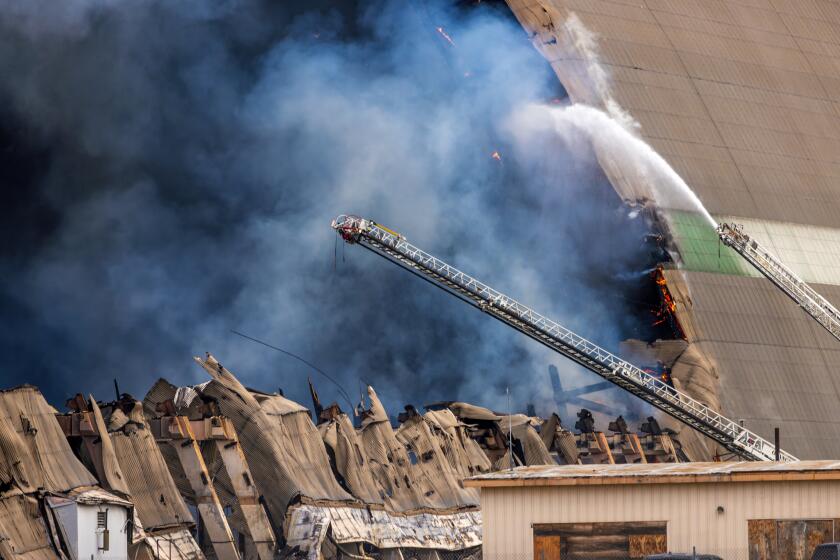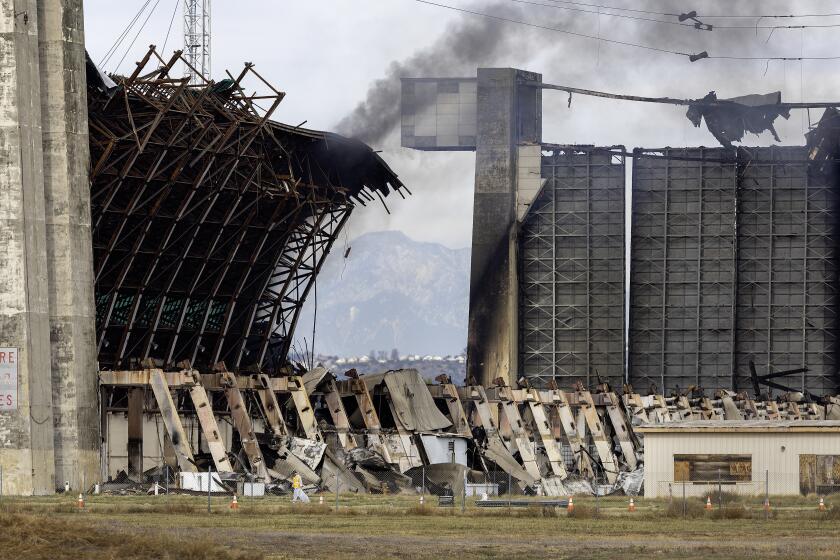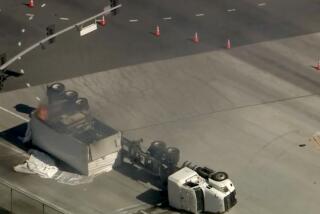Neighborhoods get little guidance about toxic risks after massive Tustin hangar fire

Johnny Schillereff and his wife, Kori, never worried about their homeâs proximity to the historic Tustin hangars. If anything, the cavernous wooden structures made the Columbus Square neighborhood where they settled after moving from Newport Beach three years ago even more attractive.
Theyâd have family dinners on their front porch and watch the moon illuminate the north hangar, which is visible through the trees that line the neighborhood park across the street. In a slice of Orange County sometimes described as sanitized, the 80-year-old relic of military history lent an aura of nostalgia, evoking a past that predated the regionâs orderly planned communities and convenient access to shopping.
For the record:
11:25 a.m. Nov. 19, 2023An earlier version of this article incorrectly referred to Columbus Square as Columbus Grove.
But on Nov. 7, the couple and their 18-year-old son woke to a smoke-filled neighborhood. The towering flames consuming the north hangar were visible from their front door. Ash and debris â later found to contain asbestos â rained down. Some neighbors, worried the fire would reach their homes, used garden hoses to soak their roofs. Others packed up their cars and left.
Many assumed the fireâs impacts would be short-lived. But the 17-story hangar smoldered for more than a week, and residents have struggled to get information about the fallout on air quality and airborne contaminants, including when debris will be removed from their properties.
âOur son is completely freaked out over it, so I have to stay calm so that he isnât afraid,â Kori Schillereff said. âBut itâs so difficult finding any information about what we should do. Iâm getting most of my information from Nextdoor.â
On Thursday afternoon, after burning for more than a week, the two massive concrete doors on either side of the north hangar and a sliver of one of the walls were all that remained. Whatâs left of the building is being razed, with deconstruction to be completed early this week.
âItâs almost like if you bought a house on a lakefront. You buy the house because you like the vibe of the lake â and the lake just dries up,â Johnny Schillereff said. âThis thing is just gone.â
Even as neighbors mourn the loss of the monumental structure, many are frustrated with how the fire was managed and a lack of clear communication about their exposure and risk level. While the property is owned by the Navy, a mix of government agencies have been involved in the firefight and aftermath, including the Orange County Fire Authority and the South Coast Air Quality Management District.
âOur biggest frustration overall is that thereâs just nobody in charge,â said Jeff Lawrence, who lives in the nearby Columbus Square neighborhood. âEverythingâs just a mess because thereâs not coordination and every agency is just independently doing their own thing with no real communication with the community.â
Section after section of the historic north hangar at the now-defunct Marine Corps Air Station in Tustin collapse in a massive fire. Whatever remains will be demolished.
In the early hours of the fire, officials said there were no concerns about asbestos exposure. But the presence of asbestos and other metals in the World War II-era building has been documented in reports dating back years.
On the day of the fire, the South Coast Air Quality Management District deployed a mobile monitor to measure for hazardous substances in the air, including lead and arsenic. That day, âfor short periods of timeâ the monitor recorded elevated levels of lead and arsenic inside the smoke plume, according to information posted on the city of Tustinâs website.
On the second day of the fire, the air quality district placed monitors at four locations near the hangars â Veterans Sports Park, the Orange County Sheriffâs Regional Training Academy, Legacy Magnet Academy and Amalfi Apartments â to test for asbestos. Samples collected Nov. 8-12 showed no asbestos, according to reports.
In the days that followed, the Navy, city of Tustin, Environmental Protection Agency and air quality district deployed 51 air monitors across a roughly 3.5-mile radius around the hangar. They found particulate matter to be âwell below any level of concern,â according to the city.
But asbestos has been detected in samples of ash and debris collected at Veterans Sports Park and near the hangar. The air quality district wrote the materials âshould be considered hazardous and avoided.â As the fire continued to burn, strong Santa Ana winds fueled concerns that contaminated materials could be carried across the county.
âMore systematic sampling is really needed to determine whatâs going on at the community level,â said Michael Kleinman, a UC Irvine professor in the Department of Environmental and Occupational Health. This, he added, should include sampling upwind and downwind of the fire and analyzing how the wind may have affected debris movement.
Asbestos is a mineral fiber that until the 1970s was widely used in building products and insulation materials because of its resistance to heat and corrosion. The material, which has been linked to mesothelioma and other lung cancers, is no longer widely used. However, itâs still found in older buildings, including the hangars, which were built in 1942.
Asbestos becomes a health hazard when the dust becomes airborne and is inhaled. The fibers can embed in human lungs and cause issues years later. While thereâs no safe level of exposure, Kleinman said, âthe risk goes up the more youâre exposed with higher doses and with a longer exposure time.â
On Friday, five members of Congress who represent Orange County sent a letter to the South Coast Air Quality Management District pushing for additional testing on air quality and debris.
The Tustin blimp hangars were Orange Countyâs version of the Watts Towers: beloved architectural marvels of a bygone time. They shouldnât have suffered such an ignominious end.
When the fire broke out, parents sent their children to school with the understanding they would be kept indoors because of poor air quality. But amid early confusion, not all schools complied, and at least one parent said his child came home bearing plastic bags of debris from the fire that had blown onto the elementary school campus.
The Tustin Unified School District later closed all campuses and hired a contractor to clean schools before they reopened. As of Friday, about a dozen campuses remained closed. Still, some parents worry their kids were exposed to asbestos.
âMy daughter has her friend group chats, and the kids talk about cancer now,â Lawrence said. âYou donât really think about that as a topic 10- or 11-year-olds should be discussing on a daily basis.â
Some residents have paid to get the interiors of their homes tested. One report provided to The Times by a Columbus Square homeowner said asbestos was detected on the kitchen and living room floors.
OC Animal Care, which operates a large shelter across the street from the hangar property, said Sunday it was closing on-site operations to the public through Tuesday â and potentially longer â given lingering concerns about air quality. Shelter officials are calling on the community to help place foster dogs, and urged people who come across a stray animal to exhaust all efforts to find the owner before bringing an animal to the shelter.
On Thursday afternoon, crews dressed in white hazmat suits with respirators walked streets near the hangar collecting debris in trash bags.
John Avalos, who lives roughly a mile from the hangars, was one of several people who stopped by the site to take photos of what remained. Rain from a day earlier seemed to have extinguished the last remnants of fire.
âIâve been taking photos just to see how itâs been progressing, because there have been so many flare-ups,â Avalos said. âItâs really sad.â
Thursday was the first day since the fire erupted that the Schillereff family felt it was OK to take their long-haired dachshund, Mr. Rogers, out for a walk rather than ferrying him by car to the community dog park. Even so, strolling through the neighborhood park, they wondered just how safe it was.
âWeâre still getting mixed information,â Johnny Schillereff said. âAnd itâs not very comforting when you go out to walk your dog and thereâs still people walking around in hazmat suits picking up debris.â
More to Read
Sign up for Essential California
The most important California stories and recommendations in your inbox every morning.
You may occasionally receive promotional content from the Los Angeles Times.












